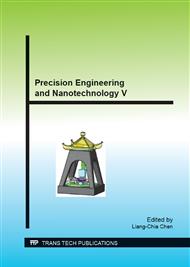p.411
p.417
p.423
p.430
p.437
p.446
p.453
p.458
p.463
A Study of Computer Controlled Ultra-Precision Polishing of Silicon Carbide Reflecting Lenses for Enhancing Surface Roughness
Abstract:
Reflecting lens is an important component of optical systems, such as high-resolution cameras, large space telescopes and meteorological satellites etc. Among the lens materials, Silicon Carbide (SiC) has attracted a lot of attention as an important optical material because of its excellent mechanical and physical properties. Apart from the form accuracy, the attainment of a consistently high optical quality in polishing SiC is still of a concern. There are advanced ultra-precision polishing machines that can correct geometrical errors and surface finish of the workpiece. These include surface roughness and waviness. However, the hardness of SiC material itself put an challenge for polishing process. In this paper, A computer controlled ultra-precision polishing (CCUP) method based on mechanical polishing is used to produce the SiC lens. Experiments are being designed on a 7-axis ultra precision polishing machine (Zeeko IRP200). As it is difficult to find out slurry which is harder than SiC so that the conventional polishing slurry is be used. It provides a nice consequence that it also efficient when the polish powder is softer than the machined materials. The tool pressure, polishing head speed and the feed rate are varied and optimized to obtain the best reflectivity of the lens being polished. A pilot experiment will be conducted for the corrective polishing for the form error of the optical surface made of SiC. The result from the study will provide an important means to optimize the process for machining SiC reflective lens using the CCUP process.
Info:
Periodical:
Pages:
437-445
Citation:
Online since:
August 2014
Authors:
Keywords:
Price:
Сopyright:
© 2015 Trans Tech Publications Ltd. All Rights Reserved
Share:
Citation:


